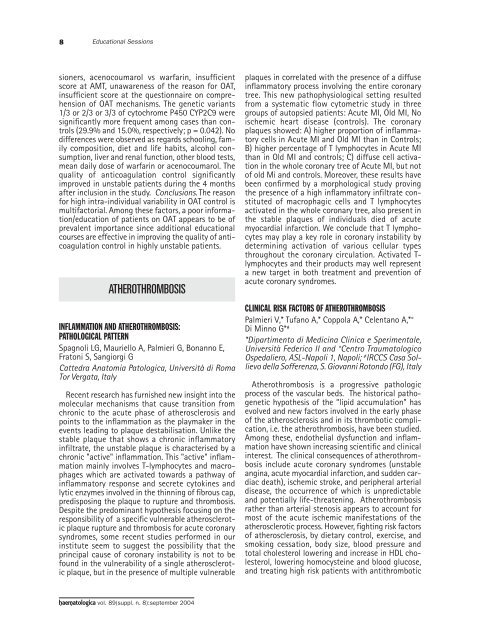Haematologica 2004;89: supplement no. 8 - Supplements ...
Haematologica 2004;89: supplement no. 8 - Supplements ...
Haematologica 2004;89: supplement no. 8 - Supplements ...
- No tags were found...
Create successful ePaper yourself
Turn your PDF publications into a flip-book with our unique Google optimized e-Paper software.
8Educational Sessionssioners, ace<strong>no</strong>coumarol vs warfarin, insufficientscore at AMT, unawareness of the reason for OAT,insufficient score at the questionnaire on comprehensio<strong>no</strong>f OAT mechanisms. The genetic variants1/3 or 2/3 or 3/3 of cytochrome P450 CYP2C9 weresignificantly more frequent among cases than controls(29.9% and 15.0%, respectively; p = 0.042). Nodifferences were observed as regards schooling, familycomposition, diet and life habits, alcohol consumption,liver and renal function, other blood tests,mean daily dose of warfarin or ace<strong>no</strong>coumarol. Thequality of anticoagulation control significantlyimproved in unstable patients during the 4 monthsafter inclusion in the study. Conclusions. The reasonfor high intra-individual variability in OAT control ismultifactorial. Among these factors, a poor information/educatio<strong>no</strong>f patients on OAT appears to be ofprevalent importance since additional educationalcourses are effective in improving the quality of anticoagulationcontrol in highly unstable patients.ATHEROTHROMBOSISINFLAMMATION AND ATHEROTHROMBOSIS:PATHOLOGICAL PATTERNSpag<strong>no</strong>li LG, Mauriello A, Palmieri G, Bonan<strong>no</strong> E,Fratoni S, Sangiorgi GCattedra Anatomia Patologica, Università di RomaTor Vergata, ItalyRecent research has furnished new insight into themolecular mechanisms that cause transition fromchronic to the acute phase of atherosclerosis andpoints to the inflammation as the playmaker in theevents leading to plaque destabilisation. Unlike thestable plaque that shows a chronic inflammatoryinfiltrate, the unstable plaque is characterised by achronic "active" inflammation. This "active" inflammationmainly involves T-lymphocytes and macrophageswhich are activated towards a pathway ofinflammatory response and secrete cytokines andlytic enzymes involved in the thinning of fibrous cap,predisposing the plaque to rupture and thrombosis.Despite the predominant hypothesis focusing on theresponsibility of a specific vulnerable atheroscleroticplaque rupture and thrombosis for acute coronarysyndromes, some recent studies performed in ourinstitute seem to suggest the possibility that theprincipal cause of coronary instability is <strong>no</strong>t to befound in the vulnerability of a single atheroscleroticplaque, but in the presence of multiple vulnerableplaques in correlated with the presence of a diffuseinflammatory process involving the entire coronarytree. This new pathophysiological setting resultedfrom a systematic flow cytometric study in threegroups of autopsied patients: Acute MI, Old MI, Noischemic heart disease (controls). The coronaryplaques showed: A) higher proportion of inflammatorycells in Acute MI and Old MI than in Controls;B) higher percentage of T lymphocytes in Acute MIthan in Old MI and controls; C) diffuse cell activationin the whole coronary tree of Acute MI, but <strong>no</strong>tof old Mi and controls. Moreover, these results havebeen confirmed by a morphological study provingthe presence of a high inflammatory infiltrate constitutedof macrophagic cells and T lymphocytesactivated in the whole coronary tree, also present inthe stable plaques of individuals died of acutemyocardial infarction. We conclude that T lymphocytesmay play a key role in coronary instability bydetermining activation of various cellular typesthroughout the coronary circulation. Activated T-lymphocytes and their products may well representa new target in both treatment and prevention ofacute coronary syndromes.CLINICAL RISK FACTORS OF ATHEROTHROMBOSISPalmieri V,* Tufa<strong>no</strong> A,* Coppola A,* Celenta<strong>no</strong> A,*°Di Min<strong>no</strong> G* #*Dipartimento di Medicina Clinica e Sperimentale,Università Federico II and °Centro TraumatologicoOspedaliero, ASL-Napoli 1, Napoli; # IRCCS Casa Sollievodella Sofferenza, S. Giovanni Rotondo (FG), ItalyAtherothrombosis is a progressive pathologicprocess of the vascular beds. The historical pathogenetichypothesis of the “lipid accumulation” hasevolved and new factors involved in the early phaseof the atherosclerosis and in its thrombotic complication,i.e. the atherothrombosis, have been studied.Among these, endothelial dysfunction and inflammationhave shown increasing scientific and clinicalinterest. The clinical consequences of atherothrombosisinclude acute coronary syndromes (unstableangina, acute myocardial infarction, and sudden cardiacdeath), ischemic stroke, and peripheral arterialdisease, the occurrence of which is unpredictableand potentially life-threatening. Atherothrombosisrather than arterial ste<strong>no</strong>sis appears to account formost of the acute ischemic manifestations of theatherosclerotic process. However, fighting risk factorsof atherosclerosis, by dietary control, exercise, andsmoking cessation, body size, blood pressure andtotal cholesterol lowering and increase in HDL cholesterol,lowering homocysteine and blood glucose,and treating high risk patients with antithrombotichaematologica vol. <strong>89</strong>(suppl. n. 8):september <strong>2004</strong>
















